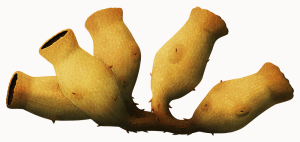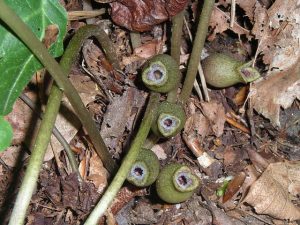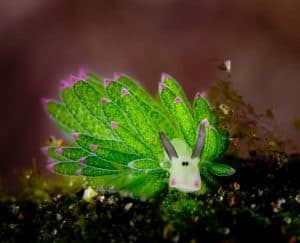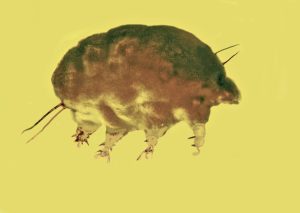Podcast: Play in new window | Download (Duration: 10:00 — 11.1MB)
It’s Invertebrate August! These creatures are the most invertebrate-y of all!
Further reading:
Horodyskia is among the oldest multicellular macroorganisms, finds study
A painting of diskagma, taken from the top link above:

Little brown jug flowers (not related to diskagma in any way!):

Show transcript:
Welcome to Strange Animals Podcast. I’m your host, Kate Shaw.
This episode started out as the March 2025 Patreon episode, but there was more I wanted to add to it that I didn’t have time to cover in that one. Here’s the expanded version to kick off Invertebrate August, which also happens to be episode 444 and releasing on August 4th! It’s about two mystery fossils.
The first is named Diskagma, which means disc-shaped fragment, and it was only described in 2013. That’s partly because it’s so small, barely two millimeters long at most, and partly because of where it’s found. That would be fossilized in extremely old rocks.
When I saw the illustration accompanying the blog post where I learned about Diskagma, I thought it was a cluster of cup-like flowers, sort of like the flowers of the plant called little brown jug. I was ready to send the link to Meredith Hemphill of the Herbarium of the Bizarre podcast, which by the way you should be listening to. But then I saw how old Diskagma is.
It’s been dated to 2.2 billion years old. That’s older than any plant, probably by as much as a billion years.
Even more astounding, it lived on land.
As a reminder, the Cambrian explosion took place about half a billion years ago, when tiny marine animals diversified rapidly to fill new ecological niches. That happened in the water, though, mainly in shallow, warm oceans. If you go back to around 850 million years ago, that may have been roughly the time that land plants evolved from green algae that lived in fresh water. Plant-like algae, or possibly algae-like plants, might be as old as 1 billion years old. But before then, scientists don’t find evidence of anything except microbes living on land, and they were probably restricted to lakes and other bodies of fresh water. That’s because there wasn’t much soil, just broken-up rock that contained very few nutrients and couldn’t retain much water.
Diskagma was shaped like a tiny elongated cup, or an urn or vase, with what looks like a stem on one end and what looks like an opening at the other end. The opening contained structures that look like little filaments, but the filaments didn’t fill the whole cup. Most of the cup was diskagma’s body, so to speak, although we don’t know what it contained. We also don’t know what the filaments were for. We do know that the stem actually did connect diskagma to other cups, so that they lived in little groups. We don’t know if it was a single animal with multiple cuplike structures or if it was a colony, or really anything.
That’s the problem. We don’t know anything about diskagma except that it existed, and that it lived on land 2.2 billion years ago. Tiny as it was, though, it wasn’t microscopic, and it definitely appears more complex than would be expected that long ago, especially from something living on dry land.
One suggestion is that the main part of its body contained a symbiotic bacteria that could convert chemicals to nutrients. As in many modern animals, especially extremophiles, the bacteria would have had a safe place to live and the diskagma would have had nutrients that allowed it to live without needing to eat.
Diskagma lived at an interesting time in the earth’s history, called the great oxygenation event, also called the great oxidation event. We talked about it in episode 341 in conjunction with cyanobacteria, because cyanobacteria basically started the great oxygenation event. Cyanobacteria are still around, by the way, and are doing just fine. They’re usually called blue-green algae even though they’re not actually algae.
Cyanobacteria photosynthesize, and they’ve been doing so for far longer than plants–possibly as much as 2.7 billion years, although scientists think cyanobacteria originally evolved around 3.5 billion years ago. The earth is about 4.5 billion years old, if you were wondering.
Like most plants also do, cyanobacteria produce oxygen as part of the photosynthetic process, and when they started doing so around 2.7 billion years ago, they changed the entire world. Before then, earth’s atmosphere hardly contained any oxygen. If you had a time machine and went back to more than two billion years ago, and you forgot to bring an oxygen tank, you’d instantly suffocate trying to breathe the air. But back then, even though animals and plants didn’t yet exist, the world contained a whole lot of microbial life, and none of it wanted anything to do with oxygen. Oxygen was toxic to the lifeforms that lived then, but cyanobacteria just kept producing it.
Cyanobacteria are tiny, but there were a lot of them. Over the course of about 700 million years, the oxygen added up until other lifeforms started to go extinct, poisoned by all that oxygen in the oceans and air. By two billion years ago, pretty much every lifeform that couldn’t evolve to use or at least tolerate oxygen had gone extinct.
Since Diskagma lived during the time of the great oxygenation event, some scientists suggest that it contained microbes that photosynthesized sunlight into nutrients diskagma could use. And, as in cyanobacteria, the side effect of photosynthesis is oxygen, so diskagma might have been contributing to the oxygen in the air that allows us to breathe these days. On the other hand, it might not have had anything to do with photosynthesis and the great oxygenation event might have driven diskagma to extinction. We have no way to know right now.
What we do know is that 700 million years after diskagma lived, something similar appears in the fossil record. It’s called Horodyskia and its fossils have been found in rocks dating between 1.5 billion years ago to 550 million years ago. Unlike diskagma, which has only been found in rocks from South Africa, horodyskia fossils have been found in Australia, China, and North America. That doesn’t mean diskagma wasn’t widespread, just that we haven’t found it anywhere else. There aren’t all that many rocks that are over two billion years old.
Horodyskia lived in the water, specifically at the bottom of the ocean, probably in shallow water. It’s been described as looking like a row of beads on a thread. The thread seemed to be buried in the sand, and growing up from it in intervals were little pear-shaped bulbs, each no larger than a millimeter long, that stuck up through the sand into the water. There may have been little root-like structures called holdfasts that grew from the bottom of the thread to help keep it in place.
We don’t know a lot about horodyskia either. It wasn’t a plant, since it also lived long before plants evolved. A 2023 study determined that it was a multicellular creature and that it was most likely a protist. Protists are related to animals, plants, and fungi, but aren’t any of those things, and they’re an incredibly diverse group. Most are single-celled and microscopic, but not always. They include algae, amoebas, slime molds, and lots more. Horodyskia’s bulbs might have been encased in a jelly-like substance, as is common in a lot of protists. Some horodyskia specimens found in younger rocks, the ones about 550 million years old, are much smaller than the earlier specimens, with each bulb barely a fraction of a millimeter in size.
We might not know much about these strange life forms, but knowing they existed tells us that even two billion years ago, life was a lot more varied than we used to think. And that’s the most exciting thing of all.
You can find Strange Animals Podcast at strangeanimalspodcast.blubrry.net. That’s blueberry without any E’s. If you have questions, comments, or suggestions for future episodes, email us at strangeanimalspodcast@gmail.com. We also have a Patreon at patreon.com/strangeanimalspodcast if you’d like to support us for as little as one dollar a month and get monthly bonus episodes.
Thanks for listening!


